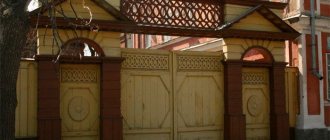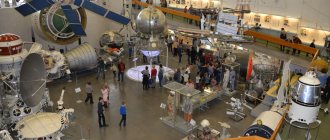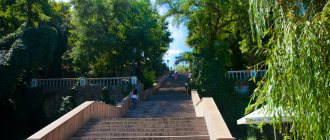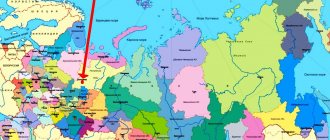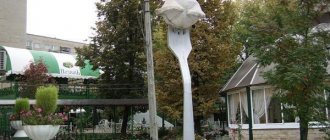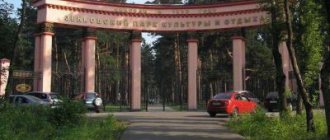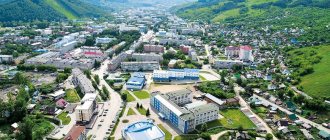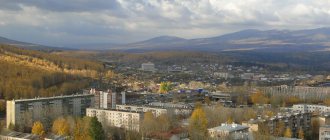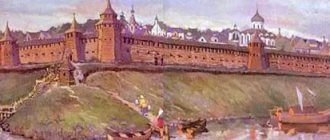The geography of Russia is vast and very interesting. There are countless cities and towns in our country. Probably not everyone knows “where Elista is on the map,” but if you clarify that this is the capital of Kalmykia, then many more people will understand what place we are talking about.
The population of Elista is 104,000 people. By the way, Elista ranks second after Astrakhan as the driest administrative center. The city received its name from the Elista ravine of the same name, where nomads in the old days set up camps. Shady trees grew here and clean springs bubbled out from under the ground. The blessed place was ideal for creating a city. The city is located in the middle of the endless Kalmyk steppes and this is one of its highlights. The spirit of freedom and free steppe life hovers here. The climate of Elista corresponds to the steppe, that is, there are hot summers and cold winters, the wind blows. In this area, the temperature in winter drops very low; thermometers show -40 degrees. At the same time, meteorologists warn that due to changes in climate processes, the temperature in Kalmykia may begin to drop even lower.
Representatives of almost all world religions live in Elista, but most of all there are Buddhists. Moreover, Kalmykia is the only region in all of Europe where Buddhism is traditionally practiced. He came here back in the 16th century. Kalmyks themselves are calm and cheerful people. They are not afraid to look their interlocutor in the eyes. Kalmyks always smile, not only to the people nearby, but also to the space around them: the sun, the sky, the steppe. Of course, the character of the Kalmyks was influenced by Buddhism, which advocates loving all living things and considering any obstacle in life as a useful lesson. The calmness of the Kalmyks has a beneficial effect on visitors who are accustomed to bustle and stress. Charged with local relaxation, many here rest their souls and return home peaceful and partially revised their view of their way of thinking and lifestyle.
Walking route around Elista for 1 day
If you came to Elista for just 1 day, this is not a reason to be upset. The attractions in the capital of Kalmykia are located very compactly and conveniently, and if you wish, by carefully planning your route, you can see all the most interesting things here in 1 day.
Start your walk at the central Lenin Square. Several iconic landmarks are located here. This is a giant chessboard, melodious fountains, and the Seven Days Pagoda .
Seven Days Pagoda
© Julia Alisova
A beautiful ritual object was erected in Elista in 2005; its name is associated with the seven Buddhas who visited our world. The shape of the roof, prayer wheels, mantras written in golden letters - everything is symbolic here.
This is the main architectural object on the square. Don't miss the opportunity to make a wish: place a coin and spin the reel, thinking about good things.
The Seven Days Pagoda, as well as the nearby Golden Gate , are ideal locations for fans of social networks. You are guaranteed a lot of surprised and delighted comments!
Don't miss the Golden Gate. Local residents believe that once you walk under them, you can be cleansed of your sins. And for tourists, this is also a path to Druzhba Park . If you have free time, take a walk along the alleys of the park and admire the sculptures dedicated to the history of the Kalmyk people and their beliefs. The main characters of the park are the Buddha statue and prayer wheels. Don’t miss the “Boy and the Dragon” fountain, the “Dance” sculpture, and the “Lunar Calendar” eastern rotunda. Under its roof are symbols of the zodiac signs.
In the center of the park there is a mosaic panel “Blossom, Kalmykia!” If you come to Elista with children, take a walk through the entertainment part of the park. There are children's playgrounds, carousels, attractions, and concerts are held on holidays and weekends.
Do you like museums? Visit the National Museum of Local Lore, where you can get a closer look at the history and life of the people of Kalmykia. The hall of Buddhist art looks especially impressive.
Golden Abode of Buddha Shakyamuni
© Julia Alisova
The next point on the route is a real mecca for all travelers in Kalmykia. Magnificent khurul, the largest and most beautiful Buddhist temple in Russia, and one of the largest in Europe.
This is the “Golden Abode of Buddha Shakyamuni”, and the temple will impress anyone, even the most experienced tourist. The temple complex was built in 2005.
The construction site was consecrated by the Dalai Lama XIV himself, the spiritual leader of all Buddhists in the world. Not only the main khurul, the entire territory of the temple is very beautiful: pagodas, gazebos, a huge number of prayer wheels.
It's nice to just stroll here on a clear, sunny day. However, you shouldn’t limit yourself to just a walk. You can (and should) examine the khurul from the inside; it is accessible to visitors of any religious denomination. In addition to the overall magnificent decoration, all guests are amazed by the huge 9-meter statue of Buddha - the largest in Russia and Europe.
What else should you include in your Elista itinerary for 1 day? Of course, the chess town of City Chess. An unusual complex was built in Elista in 1997, in honor of the World Chess Olympiad. There are huge chess pieces, chess matches, and interesting souvenir stalls. Don't forget to take a memorable photo with the original monument to Ostap Bender. The Great Schemer, surrounded by all 12 chairs at once, will meet you nearby.
Read more about what to do in Elista in our special material.
Read more: What to see in Elista in 1 day
History of the republican capital
In order to better understand why the numerical and national composition of Elista changed so much, let us turn to its history. It all started with Nicholas I, who in 1845 issued a decree on the settlement of the Kalmyk steppes. Before the very first settlement appeared on this site, the Kalmyks, who had long been a nomadic people, set up their camps here. The Kalmyks nicknamed this place Elista, which translated from their language means “sandy”. The entire left slope consisted of abundant loose sand. So the name was assigned to the village formed in this place.
The founder of Elista is officially considered to be Stepan Kiykov, who was previously a serf. After the abolition of serfdom, he freed himself from this yoke and in 1862, on the advice of a local resident named Bola, built the first dugout in this place. By 1865, as many as 15 households could be counted on the site of the future republican capital. It is 1865 that is today considered the year the city was founded. Elista soon became popular and known thanks to the large livestock fairs that were regularly organized in the Kalmyk steppes.
Holidays with children in Elista
If you're considering where to go on your next family vacation, Elista is a good option. Kalmykia has a lot of interesting entertainment for tourists of all ages, including children.
You can start your walk in Druzhba Park . This is a beautiful, well-kept recreation area in the very center of the city. Sometimes it is called an “open-air museum” - there are many interesting sculptures, pagodas, and gazebos. You can admire the fountains, ride the rides and carousels. You can also arrange a horseback ride or meet a real camel.
Monument to Ostap Bender
© Julia Alisova
Young chess players will certainly enjoy a visit to City Chess , and fans of the works of I. Ilf and E. Petrov will enjoy the sculpture of Ostap Bender surrounded by 12 chairs.
Kalmykia is a region with steppe flavor. You can go on an educational excursion with your children to visit the nomads. Visit a real yurt, taste Kalmyk tea with salt and milk.
Lovers of colorful photos can take pictures in national clothes, do archery, and have a photo shoot with camels. A great place for such a walk is yurt tent cities . They combine all the advantages of an educational and active excursion.
It is interesting to visit the theater for young spectators with children. The directors of the Youth Theater stage entertaining performances, puppet and dramatic. There are also children's entertainment centers in Elista. Popular with tourists and local residents are the trampoline room, the Gamezonekids the GoodZone entertainment center , and the Rio with excellent playgrounds, game rooms and animation programs.
The power of the councils
Initially, Elista itself belonged to the Astrakhan province. The situation changed only after Soviet power came to these places. This happened in 1918. Two years later, a decree was issued that formalized the creation of an autonomous region of the Kalmyk people. But at first, the authorities were based in Astrakhan in the old fashioned way.
In 1925, a decision was made to move the center of the region to the city of Elista, whose population at that time numbered about two thousand people. Since 1927, funds began to be actively allocated for the construction of cultural, administrative, household buildings, as well as residential buildings for the settlement, which was growing every year. In 1930, a decree was issued to transform the village of Elista into a city.
Holidays and festivals in Elista
Elista is a bright and interesting city, one of the cultural capitals of the South of Russia. It’s worth coming here not only for the colorful sights and spectacular views, but also for the cultural program. Holidays, traditional national shows, fairs, unusual festivals - the program of creative events in Kalmykia looks impressive!
The year begins, according to tradition, with New Year's celebrations . To celebrate the main night of the year, the whole of Elista is transformed - the festive illuminations turn on, the Christmas tree is decorated, and the souvenir markets are noisy. In the spring, the Christian part of the population celebrates Easter , and absolutely everyone looks forward to International Women's Day . April 5 is Constitution Day of the Republic .
National Tulip Festival
© Victor Martyanov
Also in May, Kalmyk Poetry Day . But Elista receives the largest number of tourists in late April - early May, for the fragrant Tulip Festival . The Tulip Festival is an international event.
It became one of the “brands” of Kalmykia, a bright event that managed to unite tourists and environmental activists. The festival raises important issues, such as caring for nature and the unique world of flora and fauna of the steppe.
The festival program includes not only walks through the flowering steppes, but here you can watch national dances, take pictures in spectacular costumes, and admire camel caravans. The unusual nature of the steppe expanses will remain in your memory for a long time.
The Victory Parade on May 9 continues the series of holidays Also in May, various national festivals take place, such as archery tournaments . This is a colorful and very interesting sight. All tea lovers should visit Elista at the end of May, when you come for Kalmyk Tea Day .
In September, the entire republic invites guests to the national cuisine festival “Tasty Kalmykia” . By the way, here you can try not only traditional Kalmyk beriks and bortsok, but also gastronomic delights from neighboring cuisines. Also in September, you can visit the gastronomic festival "Mahanfest" , where guests can taste kumys.
Kalmyks on the banks of the Volga
Kalmyk tribes appeared on the banks of the Volga and in the foothills of the Caucasus in the 16th century, pressed by the Russians, who at that time were seizing Siberia and fighting with the local khanates.
Arriving on the Volga, they founded their khanate, which was liquidated in 1771, which led to the tragic events known as the Torgut Escape. As a result, many thousands of people who did not want to surrender to imperial power died.
The Kalmyks, after consulting with Buddhist monks and astrologers, decided to migrate to the north of China, but Catherine II tried to prevent this by ordering not to let the nomads leave the empire. However, it was not possible to stop them, and an expedition was sent after them, which, however, was not crowned with success.
As a result, the population of the Volga steppes decreased noticeably, but it became more loyal, and this significantly simplified the further development of the lands, which would actively take place in the 19th century.
Appearance
Anthropologists classify Kalmyks as Mongoloids. These are the owners of a typical Asian appearance. They have a high forehead, a wide flattened face, and a narrow eye shape. Kalmyks are characterized by an epicanthus - the so-called Mongolian fold, covering the inner corner of the eye. The nose is small, flattened, small plump lips. Hair is straight, black, iris color is brown. There is a small percentage of people with relatively blond hair, as well as red hair. The skin color is dark, dark brown with a yellowish tint. Kalmyks are short, stocky, and the girls are thin. Modern youth are Europeanized, they prefer fashionable European clothes: jeans, high-heeled shoes, sweatshirts. Girls actively use cosmetics and get eyelash extensions. Costume jewelry stylized as national jewelry is in use.
Stupa of Enlightenment
Architectural monument, repository of Buddhist relics of Elista. The 11-meter Stupa of Enlightenment with a golden top symbolizes victory over difficulties and obstacles. Inside the structure there is an altar and a prayer drum “kurde” with a thousand mantras.
This is not just a monument or memorial. For believers, the Stupa of Enlightenment is a place where you can come at any time, find peace and prosperity, as well as answers to prayers and speedy enlightenment.
The territory is surrounded by ropes with colorful flags and mantras so that the wind spirits carry prayer throughout the world. Near the Elista landmark there is a statue of the defender of Buddhist teachings.
Location: Ostap Bender Avenue (you can get there on your own by bus No. 7 from the center of the capital or by car, moving along Lenin in the direction of the 9th microdistrict).
Food
The Kalmyk cuisine was formed under conditions of a nomadic lifestyle. It is quite simple and characterized by monotony. Before the transition to sedentism, food consisted mainly of meat and milk from animals raised by the Kalmyks: goats, sheep, cows. It is known that nomadic peoples, in particular the Kalmyks, could eat the meat of a dead animal, which is considered carrion. They also ate field mice. Later, the diet was diversified with pork and poultry. With the development of melon growing and gardening, melons, watermelons, apples, and pears appeared on the table. They started making preserves and jams. The basis of nutrition now consists of dairy products, lamb, and beef. Spices used include onion, garlic, and bay leaf. Thanks to the large presence of meat, fatty dairy products, and flour, the food is nutritious and high in calories, and satisfies well. Popular dishes of Kalmyk cuisine:
- Dotour. Rich soup made from lamb giblets. The kidneys, liver, and intestines of a sheep are taken and stewed in a cauldron along with lard, blood, and milk. Then the mixture is poured with broth and boiled. Served with onions.
- Börigi. These are Kalmyk dumplings. Made from chopped minced lamb with onions. They are shaped like pies and are much larger than in Russian cuisine.
- Bortsok. Flatbread fried in fat. Replace bread. They are eaten with first and second courses and tea.
- Cure. A lamb stomach baked in coals and stuffed with the meat of this animal.
Many healthy dishes are prepared using the milk of goats, sheep, cows, and horses. Chigyan, a lactic acid drink similar to kefir, is made by fermentation. It is considered medicinal and is often drunk by Buddhist monks. Drying sheep's cottage cheese produces a delicious dish called shyuyuryumg. Kumis is also popular. Moonshine - arak - is made from milk by distillation. Kalmyk tea (jomba) is very different from the Russian drink. It looks more like broth. Consists of tea leaves (leaf tea), water, cream, cow butter, salt, cinnamon. Toasted flour may be added. Tea warms well and gives strength.
Economy of the city
Employment of the population of Elista is provided by large industrial enterprises that exist in the republican center. The basis of the city's industry is made up of oil and gas enterprises with high average wages. There are also companies associated with the manufacturing industry, printing, clothing, and food industry. Kalmyk companies are engaged in the production and redistribution of electricity, as well as water and gas.
PJSC Kalmneft is considered one of the largest enterprises in the city. This is an oil company that engages in exploration and production drilling exclusively in open fields. The Gazprom Gas Distribution Elista enterprise also operates here, which produces and supplies natural gas.
Cloth
The Kalmyk national men's costume consists of a shirt, pants, tucked into boots. A beshmet was put on top - a fitted caftan down to the knees. It was embroidered with braid on the chest. A sheath with weapons was placed on a leather belt. In winter, they wore sheepskin coats sewn to the waist. The headdress was a fur hat like a papakha. The ceremonial version was distinguished by the addition of a red tassel that hung from the cap. The old people wore long quilted robes.
Women dressed quite simply in everyday life. Their everyday clothing was a wide shirt and trousers. Long, floor-length dresses were also common. They were fastened with metal buttons or belted. The bib was decorated with golden or silver braid. Over the dress they could wear a sleeveless robe made of colored material. The hem and bottom of the sleeves were embroidered with floral patterns. The colors of the festive dresses were bright: green, red, blue with a golden border around the edges. In summer, hats were cloth or felt hats. Women always wore hats; they were not allowed to leave the house with their heads uncovered. Festive hats were made of brocade, velvet, and richly decorated with braid patterns and embroidery. They wore morocco boots on their feet. Rich Kalmyks complemented their costume with earrings, bracelets, and necklaces. Jewelry was made from precious metals, crystal, jasper, and coral.
Church-chapel of St. George the Victorious
The church was assembled and installed in 1998. The opening of the chapel took place on the day of the Chess Olympiad. The wooden church is made in a cross-domed style and was created thanks to donations from E. Baturina. It is a valuable gift for the Elistinians. The cube-shaped church can accommodate up to one hundred parishioners at a time.
Address: Ostap Bender Avenue, Chess City. To get to the church on your own, you need to take minibus No. 7 from the city center.
Religion
Most Kalmyks profess Tibetan Buddhism. A small part is Orthodox, there are Islamists and atheists. Kalmykia is the only region in Europe where a traditional form of Buddhism is present. This religion has spread since the end of the 16th century. Before this time, there were cults of the sky (Tengrism), fire, water, earth, and mountains. Shamanism and fetishism were practiced, which involved making sacrifices and worshiping totem animals. Among the shamans there were both men and women. Some rituals have survived to this day.
House-museum of the poet D. N. Kugultinov
This is an object in memory of WWII veteran D.N. Kugultinova is a cultural landmark of the capital. David Nikitich is the only Kalmyk poet who has gained fame beyond the borders of the republic.
The house where D.N. lived Kugultinov is a two-story building that became a museum after the death of the famous poet in 2006. Inside are the veteran’s personal belongings, his photographs, letters, books and manuscripts.
Today the house is closed to visitors. But in the courtyard of the museum you can see a presentation of over ten sandstone sculptures created as part of the III International Symposium held in the late 90s. Many of the monuments were created based on Kalmyk history, folklore, and Buddhism.
Location: st. Suseeva, 23. (stops “Hotel Elista” or “Ministry of Internal Affairs”).
Names
Kalmyks use not only names derived from Oirat, but also derivatives from Tibetan, Sanskrit and Russian. Native names often come from animal names, place names, numbers or colors. Boys are also given the names of folk heroes. A common name is the mention of qualities and character traits. Sometimes names are given after the names of precious stones, celestial bodies, and planets. Some male names:
- Aldar - great;
- Baatr - hero;
- Ulan - red;
- Jirgal - happiness;
- Chon - wolf;
- Gulj - fiery;
- Bembya is the name of Saturn;
- Dorji is a diamond.
Girls are often called names of flowers, fruits, and are given feminine character traits. Often a child is given the name of a musical instrument. Female names:
- Alvina - white;
- Gerel - moon;
- Dun - graceful;
- Zambaga - magnolia;
- Kerman - squirrel;
- Lidzha - loud-voiced;
- Sarana - lily;
- Suvsana is a gem.
To protect against evil spirits, names derived from other languages were given. For example: Egor - Yagur, Nikolai - Mikula.

